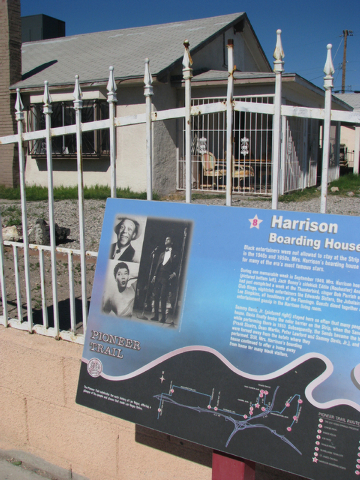Boarding house was haven for blacks during segregation
Well-known black entertainers such as Sammy Davis Jr., Pearl Bailey and Nat King Cole stayed at the Harrison Boarding House, 1001 F St.
It wasn’t that the homey atmosphere, quiet street and home-cooked meals were more appealing than staying at the casinos where they were performing. Until 1960, blacks weren’t allowed to set foot in hotels on the Strip.
The El Rancho Vegas and the Last Frontier opened in 1941 and 1942, respectively, becoming the first casinos on the Strip. The facilities and other subsequent casinos brought big-name entertainers, including many who were black. At the end of the night, they had to head to West Las Vegas, where there were several boarding houses and hotels.
“There used to be six boarding houses here on the Historic Westside,” said Stanton Wilkerson, president of the nonprofit Harrison House Inc. “The Harrison House is the only one left standing.”
The Harrison Boarding House is featured in one of the murals on the wall of the F Street connector, which is within sight of the historic structure. Sometimes called the Harrison Guest House, it began operating in 1942 much like a modern bed-and-breakfast establishment. It was built as a private home possibly as early as 1933 but more likely not long before Geneva Harrison, the original owner, opened it to lodgers.
“We’re stop No. 8 on the Pioneer Trail,” Wilkerson said. “A lot of big names stayed here, including Jack Benny’s sidekick Eddie Anderson, who played Rochester, the Edwards Sisters’ tap-dancing act and singer Arthur Lee Simpkins.”
The building is listed in the city of Las Vegas’ and Nevada’s registries of historic places, and in December, the Nevada State Museum Board nominated the house to be added to the National Registry of Historic Places.
It is an unusual and less imposing building than many that are registered as historic. The original 1942 structure has disappeared under layers of additions and renovations. Harrison added to the building over the years as the business grew, attaching a room here and there without a master plan. Later, owners continued the expansion, adding a carport. The building had several owners before it was acquired by the Ward 5 Chamber of Commerce, which operates out of the former master bedroom.
“There are stories that Ms. Harrison would sleep in the bathtub and rent out her room if that meant she could get another paying customer for the night,” Wilkerson said. “We want to take it back to as close as the original — as it stood in 1955 — as possible.”
One of the later additions the nonprofit plans to remove are window bars that were added long after Harrison’s death in 1955. The bars did not prevent the building from being vandalized in 2009 and having the wiring and copper plumbing stripped from the facility.
“We’ve got a new HVAC system in, which is critical if we’re going to have people in here,” Wilkerson said. “We’ve got new duct work and cleared out the old insulation, and we’re working on putting in new insulation. There’s hardly a day that goes by where some construction isn’t happening.”
The HVAC system was paid for by a grant from the Ward 5 Chamber of Commerce, received through the city of Las Vegas Centennial Legacy Commission.
The building is open by appointment and for special events, including the Emancipation Proclamation celebration that took place last March, the August Green Drinks event in 2013, readings and a neighborhood yard sale.
“We’ve got a lot of plans,” said Katherine Duncan, president of the Ward 5 Chamber of Commerce. “We are hoping to add solar-powered lighting and interactive features. We’d like to have buttons to press that would play recordings about the history of the Harrison House.”
One of the sitting rooms in the southwest corner of the building is the most completely renovated.
“The guests would hang out here and have their morning coffee and socialize in the early evening here,” Wilkerson said. “We’d like to have this place open at least two or three days a week and bring that kind of communication and socializing back.”
Contact East Valley View reporter F. Andrew Taylor at ataylor@viewnews.com or 702-380-4532.


















